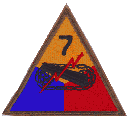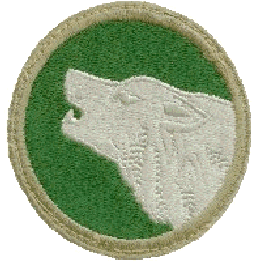Welcome to Wesley Johnston's web page dedicated to telling the story of the US non-airborne troops in Holland, part of the 7th Armored Division web site. This will always be a work in progress. So if you see something missing, please let me know. Note that the correct name of the page should use "the Netherlands", since Holland is only two provinces of the Netherlands. But I use the term "Holland" here as the Americans used it in World War II, for the entire country of the Netherlands.
Why is this page necessary? Historian Stephen Ambrose wrote "the average G.I. never was in Holland, only the airborne." (Band of Brothers, p. 248). While it is true that a large proportion of US airborne troops units did see action in Holland, during Operation Market-Garden (popularized in Cornelius Ryan's book and movie "A Bridge Too Far"), there were many US troops who fought -- and died -- in Holland. But their story is profoundly unknown to most Americans.
Why are these battles largely unknown? These are my guesses at the answer to this question.
- There is a dearth of published histories of the American troops' role in these battles.
There are only two narrative history books (see below) that I have found in English about these troops and their battles -- and one of those is an English translation of a Dutch history. Some of the events of the battles in Holland are included in the US Army Center of Military History's "Chronology: 1941-1945" by Mary H. Williams (1960), but this can hardly suffice for fully understanding the story of the U.S. troops in the Netherlands. A few books of memoirs (e.g., Robert Moranda's "Bob's Story" [38th Armd Inf Bn, 7th Armd Div]) and unit histories (e.g., Frank Armstrong's "Payoff Artillery - WWII" [263rd Fld Arty Bn]) do fill in parts of the story. And Charles Whiting's "Death on Distant Frontier" does include Overloon. But essentially there are really only these two narrative histories:
- The Siegfried Line Campaign by Charles B. MacDonald -- a 1963 volume of the "Green Books", the official history of the US Army in World War, published by the US Army's Center of Military History
- The Forgotten Battle: Overloon and the Maas Salient 1944-45 by A. Korthals Altes and N. K. C. A. in't Veld -- 1994 the English translation (published by Sarpedon) of the 1985 Dutch book
- American involvement was brief and very localized.
The longest combat was seen by 7th Armored Division, covering the 39 days from 30 September through 7 November. The other American Divisions were typically in combat only for a week or two (104ID 17 days [22 Oct - 7 Nov], 30ID 8 days [11-18 Sep], 2AD 5 days [15-19 Sep]). The Airborne troops were there longer (101AB 73 days [17 Sep - 28 Nov], 82AB 56 days [17 Sep - 11 Nov]). The non-Airborne American troops had narrowly defined isolated (from other American units) sectors.
- Many of the records are not in American archives.
Since 7th Armored Division and 104th Infantry Division were attached to British Corps, the higher level records are in British archives. So are the records for supporting units, such as the British or Scots or Canadian artillery regiments that fired missions in support of the American troops.
- Far more British WWII veterans and tourists visit Holland than do Americans.
A market to appeal to British tourists and veterans is simply going to flourish a lot better than a market aimed at American veterans and tourists. I do not mean to say that this is crassly commercial, but it is just how the forces of resources focus the research directions, as well as the directions of which veterans to invite for commemorative ceremonies. The result is that even in the Netherlands some localities do not know much at all about the role of the Americans who fought and died there, though they do know a great deal about the British and Canadian troops.
When did American troops enter combat in the Netherlands, and what US troops were involved?
- 10 September 1944: 2nd Armored and 30th Infantry Divisions Take Holland's SE Panhandle
The First US Army's XIX Corps moved from the Belgian-Dutch border, pushing the Germans across the far southeast part of Holland to the German border, ending their combat in Holland on 19 September.
- 17 September 1944: Operation Market-Garden: 82nd and 101st Airborne Divisions in Central Holland
The 82nd and 101st Airborne Divisions helped to open and secure a corridor north from the Belgian border through Nijmegen to near Arnhem. These events are very well known, thanks to "A Bridge Too Far" and have many other websites (such as www.marketgarden.com and Wings of Liberation). So this present page is focused on the other American units that fought in Holland, before and after Market-Garden. The later actions of the 7th Armored Division and the 104th Infantry Division can be viewed as to the east and to the west, respectively, of the corridor/salient created in Operation Market-Garden. NOTE: It is important to note something else which I am currently not including here but which does deserve recognition: the airborne troops who stayed on the lines even after Operation Market-Garden had failed to secure the Arnhem bridge. If I find that there is no other web page covering this, I may include coverage here.
- 29-30 September 1944: 7th Armored Division, 113th Cavalry Group, 82nd Engineer Combat Battalion, 744th Tank Battalion, and a Tank Destroyer Group enter combat in SE Holland
- Combat Command "A" of 7th Armored Division began the battle for Overloon, Holland. The Division would remain in combat for most of the period through 7 November, including stopping the 27 October German counter-attack at Meijel. For most of this period 7AD was attached to British 8 Corps. At least part of 7th Armored Division remained in Holland until 17 December, though they saw no more combat in the Netherlands. Companies "A" and "C" of the 82nd Engineer Combat Battalion were attached to 7th Armored, as was an as-yet-unidentified 4.5-inch gun battalion.
- The 113th Cavalry Group was well south of 7th Armored Division, with the 1st Belgian Brigade between them. On 29 September, as 7th Armored Division moved into attack position further north, the 113th Cavalry Group (113th Cavalry Reconnaissance Squadron & 125th Cavalry Reconnaissance Squadron) attacked north of Sittard. Their days of combat in the Netherlands apparently ended 4 October, though it seems that the Group remained in Holland at least into November. The 744th Tank Battalion and Company "B" of the 82nd Engineer Combat Battalion were attached to the 113th.
- There was also an as-yet-unidentified American Tank Destroyer Group attached to the 1st Belgian Brigade, who were in combat 29 September - 2 October, though it is not yet known how long they remained in Holland. (It is known that 6th Tank Destroyer Group was in the Heerlen area in November and start of December, when the 7th Armored Division was also reorganizing in the same area. So it may be that they had been near each other in the earlier combat as well, though this has not yet been verified.)
- 22 October 1944: 104th Infantry Division enters combat in the Battle for the Scheldt Estuary in SW Holland
The 104th Infantry Division's baptism of fire came as part of the British 1 Corps in the Second Canadian Army as part of the large and important effort to drive the Germans from the Scheldt Estuary and thus permit the Allies to safely use the port of Antwerp. The 104th completed their mission by 7 November and were then sent into Germany as part of First US Army, thus seeing no further combat in the Netherlands.
First Burials at Margraten: November 10, 1944
On the afternoon of November 10, 1944, the first burials took place in the new temporary U.S. Military Cemetery at Margraten, Holland. Troops of the 7th Armored Division's 87th Cavalry Reconnaissance Squadron had arrived in Margraten on November 9, right after the 11-day battle at Meijel, Ospel and Liesel. The 87 Recon men would remain bivouaced at Margraten for another week. But many of those who were buried there that same week remain there still.
It is fitting that, on that afternoon of November 10, two of the first three burials at Margraten were members of 7th Armored Division's 38th Armored Infantry Battalion (38 AIB).
- The first burial, in Section A, Row 1, Grave 1, was Cpl. John D. Singer (33 007 929) of the 29th Infantry Division in XIX Corps [who apparently died in Germany, though I have not been able to verify this].
- The second burial, in Grave 2, was 38 AIB's Pvt. Joseph A. Surowiec of Buffalo, NY, who died November 9 of wounds suffered as a member of Company "A" near Ospel, Holland on November 5. (Pvt. Gordon Loomis, who was wounded with him, died November 6 and was buried at the temporary U.S. Military Cemetery at Henri-Chapelle, Belgium.)
- The third burial at Margraten that November afternoon, in Grave A-1-3, was 38 AIB's Company "A" Pvt. Claudius H. Chappell of Paducah, KY, who had been wounded with Surowiec and Loomis and who, like Surowiec, succumbed to his wounds on November 9. Both Surowiec and Chappell are shown as being buried at 3:30PM that afternoon.
The remains of Singer and Surowiec were later returned to the United States for final burial. Chappell was reinterred in Margraten when it was converted into a permanent US Military Cemetery. Thus Claudius Chappell of Company C, 38th Armored Infantry Battalion, 7th Armored Division has been buried at Margraten longer than anyone else.
Many of the men of 7th Armored Division who had died in battle in the Netherlands remained unfound at that time. Some of them have since been found, and some of those are now buried in the permanent cemetery that was later established at Margraten. Some of them have never been found and lay there still, in unmarked graves, waiting to be found, still listed as Missing in Action but now having had an administrative Finding of Death.
How did so many men of the 7th Armored Division die in the fields and bogs and swamps of Holland?
The 7th Armored Division had fought across France, liberating Chartres, making the first crossing of that part of the Seine River upstream of Paris, liberating the WWI sites of Chateau-Thierry and Verdun, coming to a crashing halt in the very different terrain of the highly-fortified area of Metz. On September 25, 1944, the Division was transferred from Third US Army in France and sent north to the Netherlands.
Three periods of combat
7th Armored Division's combat role in the Netherlands can be broken into three periods, followed by a period out of combat:
- 29 September - 6 October: The Battle for Overloon
- 7 October - 26 October: Action at Griendtsveen - Patrolling Ell-Weert-Meijel-Deurne
- 27 October - 7 November: Battle of the Canals: Ospel-Meijel-Liesel
- 7 November - 17 December: Reorganizing and Retraining (Some elements of 7AD entered combat in Germany in early December, while other elements of the Division remained in reserve across the Dutch-German border in the Netherlands.)








